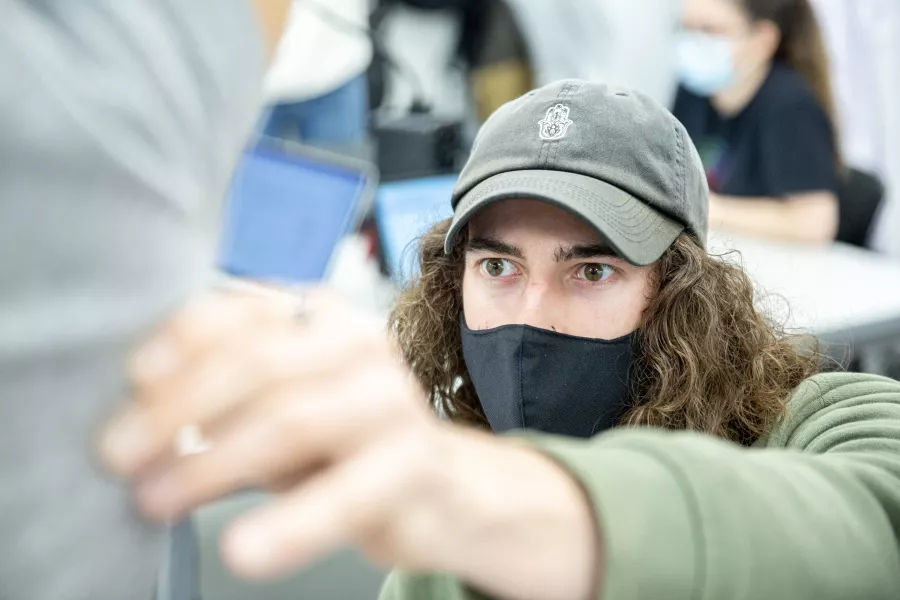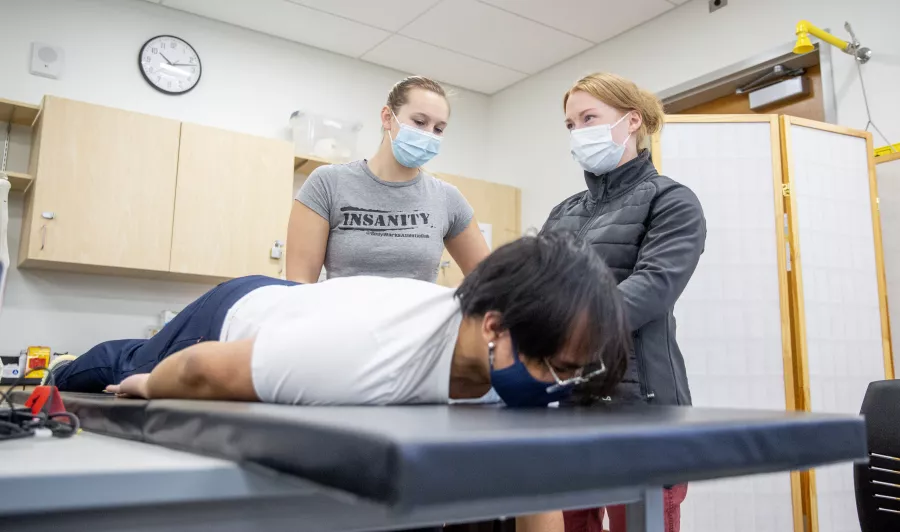It takes some getting used to,” says WWU Lab and Classroom Support Technician Becky Lancaster, ‘13, B.S., kinesiology, in reference to Hera and Achilles, the two visitors to Western’s new Anatomy and Physiology Lab that I had come to see.
The lab, located in a nondescript section of Carver, hosts students from biology and kinesiology classes for hands-on work rarely offered to undergraduates: the chance to learn and better understand human anatomy by working on actual human bodies.
Hera and Achilles are cadavers, named by the students as a more dignified way of referring to them than “the female cadaver” and “the male cadaver.”
I’m escorted into the lab by Lancaster and Biology Senior Instructor Janice Lapsansky, ’90, B.S., biology. I meet Achilles first, as Lancaster rolls a gurney into place.
“Most people are fine,” says Lapsansky, “But pay attention to how you are feeling.” I certainly have some butterflies as Lancaster uncovers the cadaver; the face, and Hera’s, remain covered at all times, even to the students who work on them daily, to reduce the emotional impact that would come with that.
I first notice the cadaver smells clean, antiseptic and somehow dry, like a medicine cabinet that hasn’t been opened in years. The skin is pale white and almost translucent, having been drained of all fluids long before.
It dawns on me that the rush of feelings I am experiencing, from “I wonder who he was,” to “How did he get here?” likely will be shared by hundreds of Western students who will also meet Hera and Achilles this academic year.
Planning Ahead
Painted on one wall of the lab is the translation of a Latin phrase, “Hic locus est ubi mors gaudet succurrere vitae,” found on the walls of many anatomy and pathology labs around the world: “This is the place where death rejoices to teach those who live.” Lapsansky says the motto guides all that they do in the lab, but getting that phrase up on that wall took about seven years of really hard work.
“There were a couple of times when I thought it just wasn’t going to happen,” she says. “But somebody on the faculty side would always pick the ball back up and keep running with it.”
A cadaver lab had been long sought as a teaching tool by faculty in both Biology and Health & Human Development, and after the extensive renovation and reconstruction of Carver in 2017, Lapsansky and Health and Human Development Professors Jun San Juan and Keith Russell began working on making it happen.
One thing that wasn’t as tough a sell was touting the uniqueness of having a lab like this in an undergraduate-focused public university that didn’t have an attached medical school, and how such a rare opportunity would better prepare students for graduate studies.
After about a year of delay, mostly due to COVID, the lab opened in fall 2021, with Achilles and Hera as its first guests. New cadavers will arrive in time for next school year, via the UW Medicine’s Willed Body Program; Hera and Achilles will stay for one more year before being cremated and their remains returned to their families.
‘A Much Bigger Undertaking’
In the lab, Kinesiology major Joanna Sanok of Port Townsend is bent over Hera, examining the interplay between the muscles and tendons in the cadaver’s arm, moving a thumb to see the corresponding tug and response from the tendons.
“This really helps me understand how the human body works from more than just a theoretical way. I can see it happen right in front of me. And if I have a question, I can just find the answer out for myself,” she says.
“Many grad schools can offer an opportunity like this, but for an undergrad like myself to have the opportunity, it’s just rare,” says Sanok, who hopes to go to a graduate program to become a physician’s assistant after she leaves Western.
Calahan Warren, an exercise science grad student from Auburndale, Florida, hopes to take his experiences in the lab at Western to a kinesiology doctoral program after he graduates.
“There’s no comparing this to trying to do the same work on a model—it’s just a much bigger undertaking,” Warren says. “To be honest, things aren’t always where they are supposed to be. We’re all different. This opportunity is the best learning experience I have ever had.”
Hearing such sentiment makes Lapsansky and San Juan grin from ear to ear.
“It makes all the effort worthwhile,” says Lapsansky. “We want to support our students so they feel comfortable, but also to make sure they understand the tremendous gift they have been given by these folks who have willed their bodies to education.”
The need for health-care providers of all kinds was soaring even before the pandemic, and Lapsansky and San Juan say their classes are always full, often with waiting lists—and the opportunity to learn about human anatomy firsthand can only result in more and better trained nurses, kinesiologists, biologists, doctors, physical therapists and more.
But none of this would be possible without Hera and Achilles, and the decisions they made while they were still alive about how they could continue to serve long after they were gone.
“They are the real heroes,” says Lapsansky.


